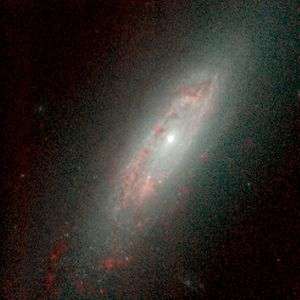NGC 3593
| NGC 3593 | |
|---|---|
|
An infrared Hubble Space Telescope (HST) image of NGC 3593. | |
| Observation data (J2000 epoch) | |
| Constellation | Leo |
| Right ascension | 11h 14m 37.002s[1] |
| Declination | +12° 49′ 04.87″[1] |
| Redshift | 627[2] km/s |
| Distance | 20.5 Mly (6.28 Mpc)[2] |
| Apparent magnitude (V) | 12.6[3] |
| Characteristics | |
| Type | SA(s)0/a[3] |
| Apparent size (V) | 1′.5 × 1′.1[3] |
| Other designations | |
| UGC 6272,[3] PGC 34257[3] | |
NGC 3593 is a lenticular galaxy located in the constellation Leo. It has a morphological classification of SA(s)0/a,[3] which indicates it is a lenticular galaxy of the pure spiral type.[4] This is a starburst galaxy, which means it is forming new stars at a high rate. This is occurring in a band of gas surrounding the central nucleus. There is a single arm, which spirals outward from this ring.[5] It is frequently but not consistently identified as a member of the Leo Triplet group.
This galaxy is known to contain two counter-rotating populations of stars. That is, one set of stars is rotating in the opposite direction with respect to the other. One means for this to occur is by acquiring gas from an external source, which then undergoes star formation. An alternative is by a merger with a second galaxy. Neither scenario has been ruled out. The age of the lower mass, counter-rotating population is younger by about 1.6 ± 0.8 Gyr than the primary star population of the galaxy.[5]
References
- 1 2 Skrutskie, M. F.; et al. (February 2006), "The Two Micron All Sky Survey (2MASS)", The Astronomical Journal, 131 (2): 1163–1183, Bibcode:2006AJ....131.1163S, doi:10.1086/498708.
- 1 2 Crook, Aidan C.; et al. (February 2007), "Groups of Galaxies in the Two Micron All Sky Redshift Survey", The Astrophysical Journal, 655: 790–813, arXiv:astro-ph/0610732
 , Bibcode:2007ApJ...655..790C, doi:10.1086/510201.
, Bibcode:2007ApJ...655..790C, doi:10.1086/510201. - 1 2 3 4 5 6 "NASA/IPAC Extragalactic Database". Results for NGC 3593. Retrieved 2007-04-15.
- ↑ Buta, Ronald J.; et al. (2007), Atlas of Galaxies, Cambridge University Press, pp. 13–17, ISBN 0521820480.
- 1 2 Coccato, L.; et al. (January 2013), "Spectroscopic evidence of distinct stellar populations in the counter-rotating stellar disks of NGC 3593 and NGC 4550", Astronomy & Astrophysics, 549: A3, arXiv:1210.7807
 , Bibcode:2013A&A...549A...3C, doi:10.1051/0004-6361/201220460.
, Bibcode:2013A&A...549A...3C, doi:10.1051/0004-6361/201220460.
